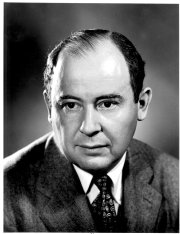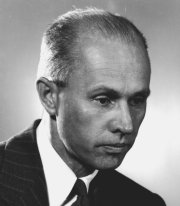



In the late summer of 1943, experimental work at Los Alamos was focused on the designs for two gun-type atomic weapons. One would fire a uranium "bullet" into a uranium "target," while the other would use plutonium bullets and targets and, to overcome problems that might be caused by impurities in plutonium, would fire the bullet at a higher velocity.
The use of a gun to assemble nuclear explosives had been proposed as early as June 1942, and although it required considerable study of the nuclear properties of uranium-235 and plutonium in the shapes they would be cast in for use as bullets and targets, it seemed the most straightforward way to proceed.
It had also occurred to Richard Tolman, a professor of physics at the California Institute of Technology and vice-chairman of the National Defense Research Committee, that fissionable material might be assembled by detonating a high explosive around a hollow sphere and crushing it into a critical mass. Because of the difficulty of implementing this idea, however, few paid much attention to it. Robert Serber, a University of California physics professor, mentioned it in his indoctrination lectures at Los Alamos in April 1943 as one of "various other shooting arrangements" that had been suggested "but as yet not carefully analyzed."
Upon hearing Serber's lectures, Seth Neddermeyer, another professor of physics from Cal Tech, seized upon the idea enthusiastically. He recognized that blowing a sphere of uranium-235 or plutonium together in this matter would assemble these materials more rapidly than a gun could and proposed that it be explored. Oppenheimer agreed to a small program, which was set up on South Mesa.
The Ordnance Engineering Group (E-5) under Neddermeyer's direction, pursued experiments there and in Pennsylvania, at the Bruceton Explosives Research Laboratory of the NDRC. At Bruceton, "implosion charges" were fabricated for them by George Kistiakowsky of Harvard University, who was head of the project. Neddermeyer and Edwin M. McMillan, a University of California physicist who traveled there with him, were impressed that when a shell of explosives surrounding an iron pipe was set off, it closed the pipe. They returned to Los Alamos to repeat the experiment, varying the explosives, the pipe size and the arrangements, and studying the remains. A small plant was built at Anchor Ranch to cast the high explosives used in these experiments.
In September 1943, Oppenheimer asked John von Neumann, a Princeton mathematician who had been working on shaped charges, fluid dynamics and the computation of ballistic trajectories as a consultant to the Army's Aberdeen Proving Ground in Maryland, to look into the theoretical problems faced at Los Alamos.
Von Neumann agreed to spend some time as a consultant, working primarily in his office at the National Academy of Sciences in Washington, D.C., but with an occasional visit to Los Alamos. His first, in September, acquainted him with the implosion program. He suggested that shaped charges would produce an appropriate spherical detonation wave and pointed out that the method was not only likely to be faster than the gun, but that it would produce higher pressures and reduce the amount of active material required, making the bomb more efficient.
The Laboratory was galvanized by von Neumann's insight. Theorist Edward Teller scolded Charles Critchfield, who had been working on the project, for overlooking the greater efficiency to be expected from implosion, and Manhattan Engineer District Commander Leslie Groves chided Navy Capt. William Parsons for focusing on the "safer" gun method.
Kistiakowsky was persuaded to come to Los Alamos to head a new program to develop the high explosives. A diagnostic program, involving X-ray and photographic techniques as well as the "terminal observations" Neddermeyer had employed, was begun.
New ideas for diagnosing an imploding system, including the use of a betatron electron accelerator, magnetic fields, electric pins and natural sources of radioactivity to produce signals that would indicate the rate of collapse inside the sphere, were subsequently introduced.
Calculations showed that an inward-moving spherical shock wave would be disrupted by the interference of detonation waves from the high-explosive segments and by instabilities arising as the tamper material was pushed into the heavier nuclear core by the implosion. This led to a fuller understanding of the behavior of a symmetric implosion and greater doubt that it could be achieved. What was needed was an explosive lens to convert the detonation wave to a spherically convergent form.
Under Kistiakowsky's direction, a new site, Sawmill, off S-Site, was constructed between December 1943 and May 1944. James Tuck, a member of the British Mission at Los Alamos, had worked in England on the use of combinations of different explosives to "focus" detonation waves and headed a group to develop an explosive lens for the implosion gadget. After von Neumann suggested a workable design for the lens, Lt. Cmdr. Norris Bradbury, a Stanford physics professor assigned to the Dahlgren Proving Ground of the U.S. Navy Ordnance Bureau, was recruited in June 1944 to solve the problem of casting the high explosives for the design.
Even if the appropriate explosive lenses could be produced, they would have to be set off simultaneously to create a symmetrical implosion. After experiments with a variety of Primacord and electric detonators, Luis Alvarez, a University of California Radiation Laboratory physicist who had come to the Laboratory from radar work at the Massachusetts Institute of Technology, and his student, Lawrence Johnson, devised such a system in May 1944.
Although progress had been made, Kistiakowsky was skeptical about the success of the program in the spring of 1944. He predicted that by October they might be able to "recommend a design of the gadget that will have a finite chance of properly functioning," but added that in "November or December the test of the gadget failed. Project staff resumes frantic work, Kistiakowsky goes nuts and is locked up." The consequences of such a failure, however, would be devastating to the program.
In the summer of 1944, Emilio Segr¸'s group at Pajarito Site found that plutonium from nuclear reactors had an isotopic impurity, plutonium-240, that prohibited its use in a gun-type assembly. Since all of the plutonium that would be used in the atomic bomb would be produced in reactors, this meant that the vast investment in the Hanford production reactors built by DuPont would go down the drain unless implosion could be perfected.
The Laboratory was reorganized to accomplish this. New division, G for gadget and X for explosives, were set up to develop the nuclear and high-explosive components of the implosion device. The Laboratory's Governing Board was divided into administrative and technical boards to manage the growing effort. Even then, the Technical Board's tasks were increasingly assumed by lower-level interdivisional committees and conferences that coordinated the effort required.
The reorganization of the Laboratory was accompanied by a vast expansion in personnel, as no stone was left unturned in the search for a suitable design and the development of suitable components for the gadget. From roughly 1,100 personnel, Laboratory employment grew within a year to more than 2,500. Implosion meant an explosion of the Laboratory population.
It was not clear, however, that the much more complicated implosion device would work. Before it could be used in combat, a test would be required.
- Robert W. Seidel
Next: Evolving from calculators to computers